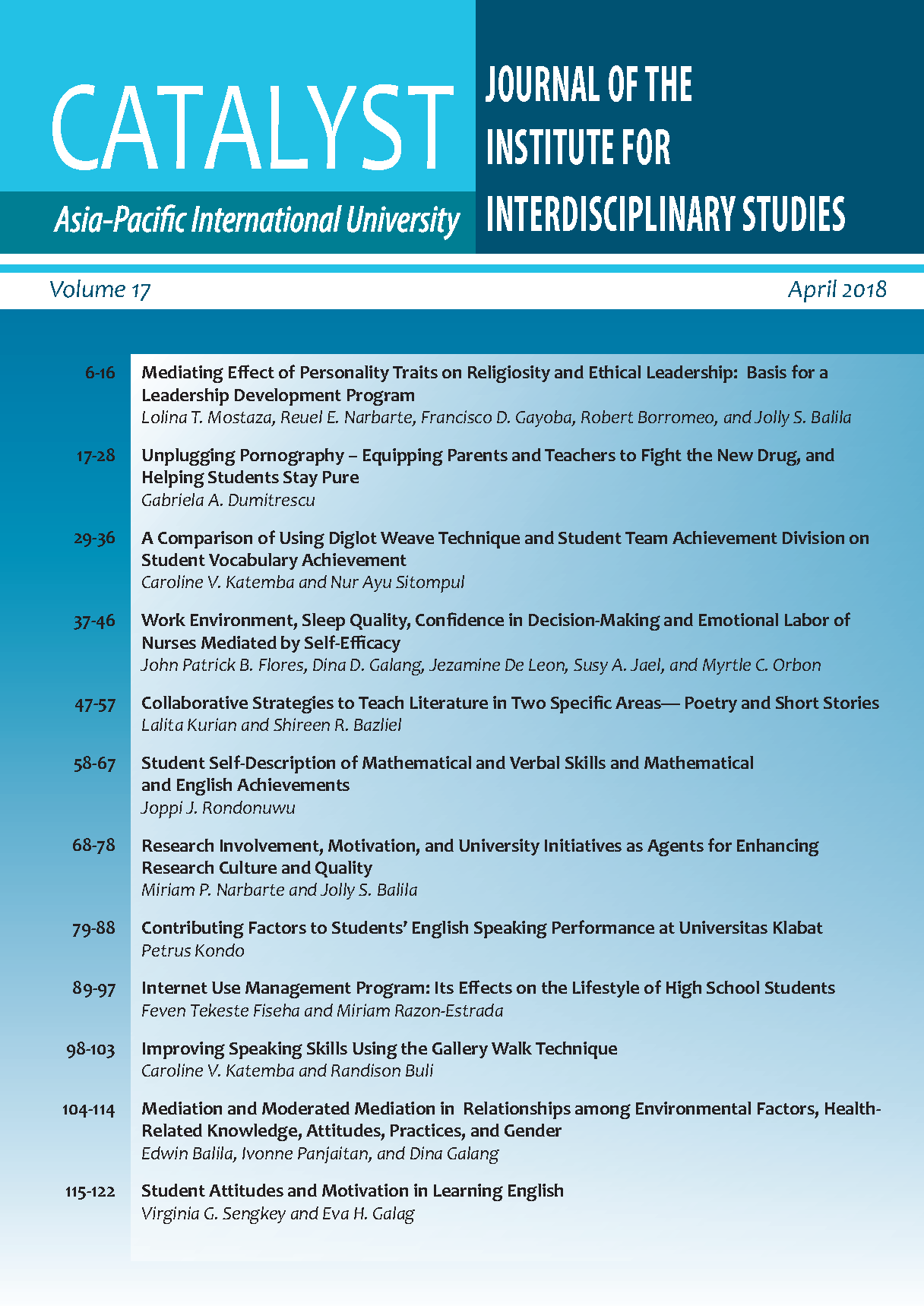Mediation and Moderated Mediation in Relationships among Environmental Factors, Health-Related Knowledge, Attitudes, Practices, and Gender
Main Article Content
Abstract
This paper addresses the mediation effects of food, built, and social environments, knowledge and attitudes on health, and the influence of the technology environment on health practices, along with gender’s moderating effects. Adolescent respondents (n=365) aged 11 to 19 years from 13 private Christian schools in West, Central and East Indonesia were involved. Structural Equation Modeling was utilized to obtain the mediation and moderation effects. It was found that the food environment, social environment, and health attitude partially mediate the technology environment on health practices. Likewise, the built environment (i) fully mediates the technology environment on food environment, and (ii) partially mediates the social environment and health attitudes. Finally, the food environment, social environment, health attitudes, and knowledge on health fully mediate, respectively, the relationship between the built environment and health practices, while knowledge on health mediates between the social environment and health practices. Moderated mediation relationships were observed such that for males, (i) technology had a greater influence on the social environment; and (ii) the technology environment had a stronger positive influence on attitudes toward health than for females. On the other hand, the relationship between the built environment and knowledge on health had a stronger negative influence on males than on females.
Article Details

This work is licensed under a Creative Commons Attribution-NonCommercial-NoDerivatives 4.0 International License.
Copyright: Asia-Pacific International University reserve exclusive rights to publish, reproduce and distribute the manuscript and all contents therein.
References
Barnett, E. & Casper, M. (2001) A definition of “social environment”. American Public health Association. 91(3), 465. Retrieved from https://www.ncbi.nlm.nih.gov/pmc/articles/PMC1446600/
Baron, R., & Kenny, D. (1986). The moderator-mediator variable distinction in social psychological research: Conceptual, strategic, and statistical considerations. Journal of Personality and Social Psychology, 51(6), 1173–1182.
Boyse, K. (2011). Obesity and Overweight. University of Michigan Health System. Retrieved from http://www.med. umich.edu/yourchild/topics/obesity.htm
Crossman, A. (2016). Understanding purposive sampling. Retrieved From http://sociology.about.com/od/Types-of-Samples/a/Purposive-Sample.htm
Del Coso Garrigós, J., García Aparicio, A., Laguna Nieto, M., Merino Merino, E., & Rodríguez Cabrero, M. (2011). Obesity prevention through physical activity in school-age children and adolescents. Universidad Camilo José Cela. September 2011. Retrieved from http:// www.ucjc.edu/universidad/profesores/marta-rodriguez-cabrero
Hakeem, R., Thomas, J., & Badruddin, S. (2001). Urbanization and health-related knowledge and attitudes of South Asian children. Journal of Pakistan Medical Association 51(12):437-443. Retrieved from http://europepmc.org/abstract/med/11850981
Harding, M. (2015). Obesity in children. Patient. Retrieved from http://patient.info/doctor/obesityin-children.
Harvard School of Public Health (2015). Environmental barriers to activity. Retrieved from http://www.hsph. harvard.edu/obesity-prevention-source/obesity-causes/physical-activityenvironment/
Institute National de Santé Quebéc (2016). The food environment around public schools and the consumption of junk food for lunch by Québec Secondary School Students. INSPQ Public Health Expertise and Reference Center June 16, 2016. Retrieved from https://www.inspq.qc.ca/en/publications/2143
Kalra, G., De Sousa, A., Sonavane, S., & Shah, N. (2012). Psychological issues in pediatric obesity. Industrial Psychiatry Journal, 21(1), 11–17. Retrieved from http://doi.org/10.4103/09726748.110941
Koehly, L., & Loscalzo, A. (2009). Adolescent obesity and social networks. Preventing Chronic Disease, 6(3). Retrieved from http://www.ncbi.nlm.nih.gov/pmc/articles/PMC2722403/pdf/PCD63A99.pdf
Lindelof A, Nielsen, C, & Pedersen, B. (2013). A qualitative, longitudinal study exploring obese adolescents' attitudes toward physical activity. Journal of Physical Activity and Health. 10(1):113-21. Retrieved from http://www.ncbi.nlm.nih.gov/pubmed/23324483
Santrock, J. (2008). Adolescence: (12th Ed). McGraw-Hill Higher Education, Boston, MA
Tsang, T., Kohn, M., Chow, C., & Singh, M. (2013). Self-perception and attitude toward physical activity in overweight/obese adolescents: the "martial fitness" study. Research in Sports Medicine. 21(1):37-51. Retrieved from http://www.tandfonline.com/doi/abs/10.1080/15438627.2012.738444?src=recsys& journalCode=gspm20
Wiley, D. & Cory, A. (2013). Health-related knowledge, attitudes, behaviors, and skills. Encyclopedia of School Health. Retrieved from http://dx.doi.org/10.4135/9781452276250.n122
World Health Organization (2014). Increasing fruit and vegetable consumption to reduce the risk of non-communicable diseases. e-library of Evidence for Nutrition Actions (eLENA).Retrieved from http://www.who.int/elena/titles/fruit_vegetables_ncds/en/


